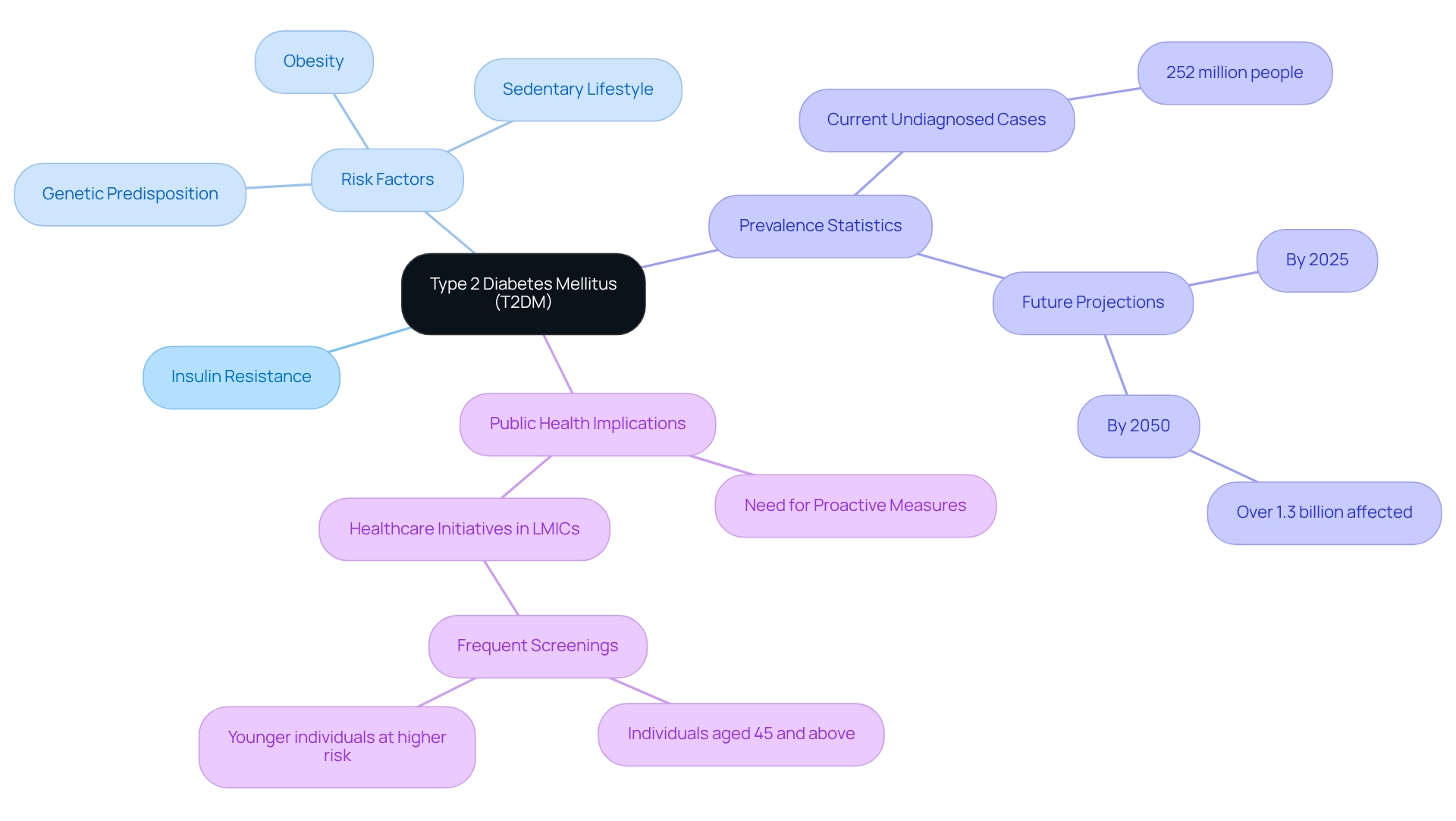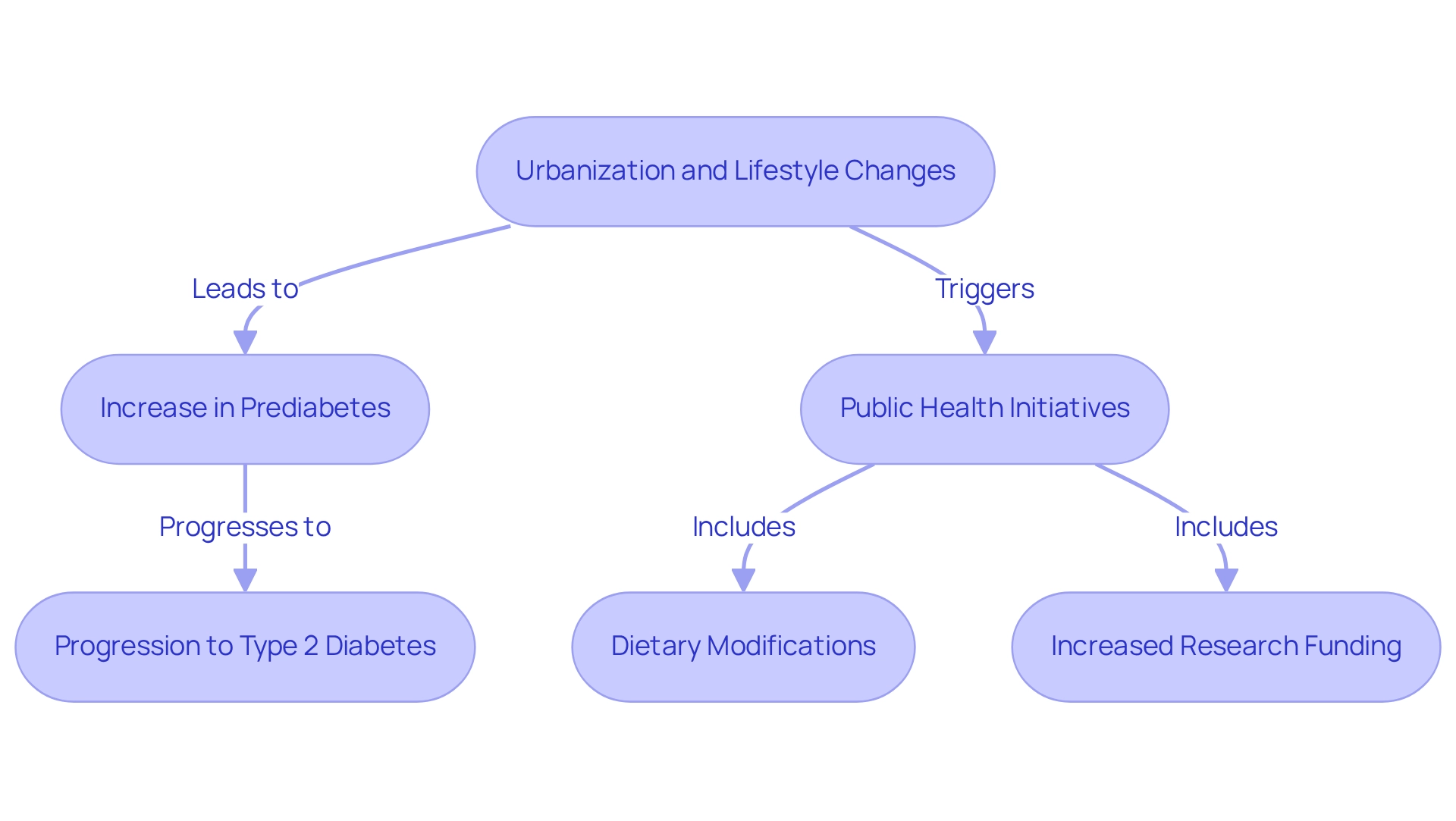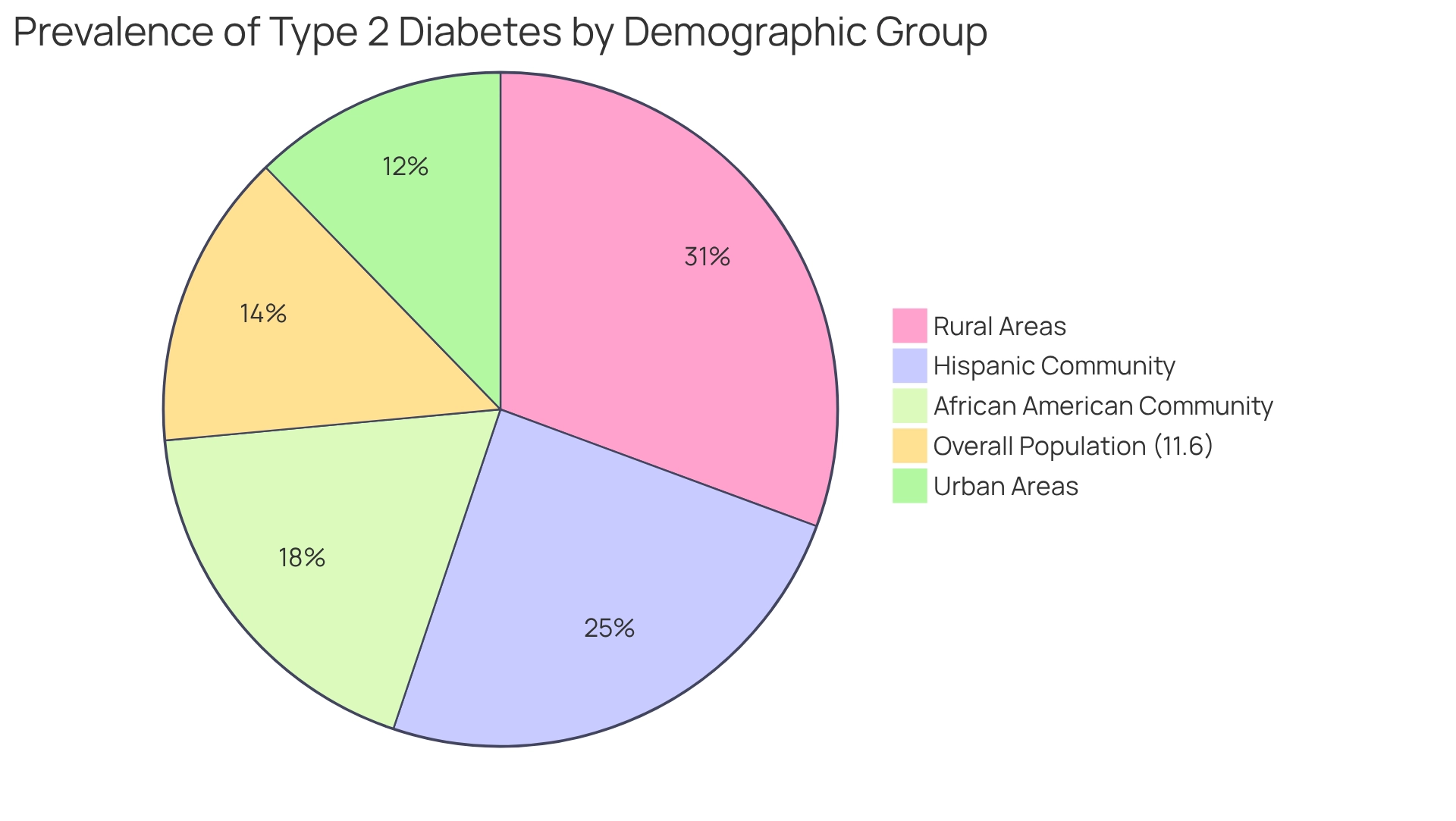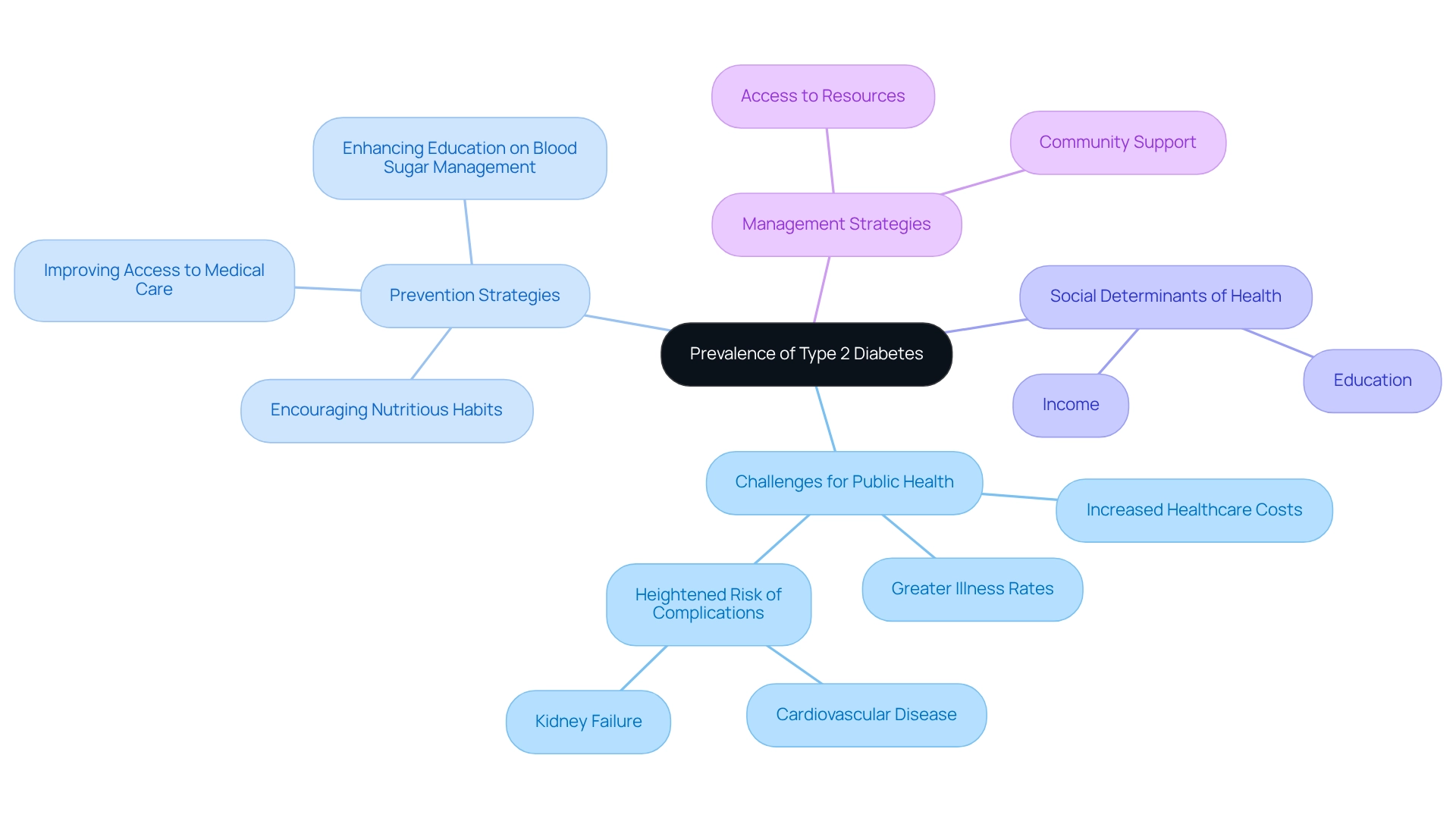Overview
This article explores the growing concern of Type 2 Diabetes Mellitus (T2DM), both globally and locally, shedding light on the significant rise in cases and the urgent need for tailored public health strategies. It's important to recognize that T2DM affects approximately 11.1% of adults worldwide, with particularly alarming growth trends in low- and middle-income countries. This situation highlights the necessity for targeted interventions that consider demographic variations and socio-economic factors.
You're not alone in this journey. As we delve into these statistics, it's crucial to understand that support is available. Together, we can work towards effective solutions that address not only the health aspects but also the emotional challenges that come with a T2DM diagnosis. We are here to support you every step of the way.
Introduction
The global epidemic of Type 2 Diabetes Mellitus (T2DM) is not just a health concern; it is a multifaceted challenge that touches every corner of society. As the most prevalent form of diabetes, T2DM is characterized by insulin resistance and affects millions worldwide. Unfortunately, projections indicate that this number will only continue to rise. The implications are staggering, as the condition is linked to severe health complications and escalating healthcare costs.
Understanding the underlying factors contributing to this crisis is essential for developing effective public health strategies. These factors range from lifestyle choices and socio-economic disparities to demographic variations. This article delves into the definitions, prevalence trends, and local statistics surrounding Type 2 Diabetes. We will also explore the critical need for tailored interventions and education to combat this growing public health issue.
Through a comprehensive approach, T2DSolutions aims to empower individuals and communities to navigate the complexities of managing diabetes. Remember, you're not alone in this journey. Together, we can strive for better health outcomes for all.
Understanding Type 2 Diabetes: Definitions and Key Concepts
Type 2 Diabetes Mellitus (T2DM) is a chronic metabolic disorder primarily characterized by insulin resistance and a relative deficiency of insulin. This condition, known for its high prevalence, accounts for roughly 90% of all diabetes cases globally, highlighting its significance as a major public health issue. Understanding T2DM begins with the concept of insulin resistance, where the body's cells struggle to respond adequately to insulin, leading to elevated blood glucose levels. Key risk factors contributing to T2DM include:
- Obesity
- A sedentary lifestyle
- Genetic predisposition
Recent forecasts suggest that by 2025, the prevalence of Type 2 diabetes worldwide will continue to rise, with predictions indicating that more than 1.3 billion people may be affected by the condition by 2050. Alarmingly, it is estimated that 252 million individuals are currently living with undiagnosed blood sugar issues, underscoring the urgent need for proactive measures in prevention and management, particularly in low- and middle-income countries (LMICs). Specialists recommend regular screenings for those aged 45 and older, as well as for younger groups at greater risk. As Md Jamal Hossain from the Department of Pharmacy, School of Pharmaceutical Sciences, State University of Bangladesh, states, "In collaboration with WHO, governments of LMICs should enhance the availability of healthcare initiatives, including more frequent screenings for individuals aged 45 years and above and for younger individuals at higher risk."
Grasping these definitions and key concepts is crucial for analyzing the implications of diabetes prevalence data on public well-being. Specialists stress that a complete understanding of T2DM and its underlying mechanisms is vital for effective intervention strategies and enhancing well-being for those impacted. Moreover, recent communications have emphasized the significant public concern regarding this condition, highlighting the pressing need for global action. The concerning prediction from the case study titled "Future Projections of Diabetes Prevalence" underscores the necessity for proactive actions in prevention and management to alleviate the looming health crisis. T2DSolutions aims to serve as a valuable resource center for education and community assistance, helping individuals navigate the complexities of managing Type 2. You're not alone in this journey, and we are here to support you every step of the way.

Global Trends in Type 2 Diabetes Prevalence: An Overview
The International Diabetes Federation (IDF) Diabetes Atlas 2025 highlights a concerning reality: approximately 11.1% of adults aged 20 to 79 are living with type 2 diabetes, making it the most prevalent form of this condition. Since 1990, the global prevalence of type 2 diabetes has escalated from 7% to 14% in 2022, and projections indicate it may reach 12.2% by 2045. It's understandable to feel alarmed by this trend, which is driven by factors like urbanization, dietary changes, and increasingly sedentary lifestyles, particularly in low- and middle-income countries (LMICs) facing the steepest rises in blood sugar-related health issues.
Longitudinal studies reveal a troubling progression from prediabetes to diabetes in these regions, underscoring the urgent need for ongoing monitoring and effective prevention strategies. In Saudi Arabia, the impact of this condition is stark, with a reported 391 thousand Disability-Adjusted Life Years (DALY) attributed to diabetes, highlighting the significant burden on public welfare.
However, there is hope. Public health initiatives focused on dietary modifications have shown promise in addressing these challenges. It's crucial to recognize the importance of tailored strategies to combat the rising prevalence of type 2 diabetes worldwide. As Viswanathan Mohan points out, effective control strategies must consider the varying risk factors associated with the condition. There is also an urgent need for increased research funding to develop effective prevention measures.
At T2DSolutions, we are dedicated to using these statistics to shape our educational resources and community support initiatives. We aim to empower newly diagnosed patients with the knowledge and tools necessary to manage their condition effectively. Remember, you're not alone in this journey; we are here to support you every step of the way.

Local Statistics on Type 2 Diabetes: A Comparative Analysis
In the United States, the Centers for Disease Control and Prevention (CDC) estimates that around 11.6% of the population, or about 38.4 million individuals, are living with high blood sugar, with Type 2 being the predominant form. It's important to recognize that diabetes type 2 prevalence rates vary significantly across different demographics. For instance, Hispanic and African American communities experience higher rates of diabetes type 2, underscoring the need for tailored public wellness initiatives. Additionally, rural areas show increased rates of blood sugar issues compared to urban environments, highlighting the necessity for localized strategies to address this growing health concern.
Recent studies shed light on the impact of socio-economic factors on diabetes type 2 prevalence. Individuals from lower socio-economic backgrounds often face greater challenges in managing their condition. As Gabriel A. Benavidez, PhD, points out, "Once a chronic condition develops, management of the disease requires the ability to afford health care and have physical access to it." This emphasizes the importance of addressing these barriers. For example, a case study examining the effects of acculturation on health risks among Hispanic immigrants reveals that earlier immigration is linked to higher obesity rates. This indicates that culturally sensitive prevention programs are vital.
Furthermore, the CDC's latest report shows that 12.6% of participants with Type 2 Diabetes developed diabetic eye disease during the Diabetes Prevention Program (DPP). This statistic serves as a reminder of the serious complications associated with the condition, as well as the management challenges faced by various demographics. Insights from healthcare experts stress the importance of recognizing demographic variations in blood sugar-related conditions to effectively manage diabetes type 2 prevalence. By understanding these local statistics and their implications, T2DSolutions can design public welfare policies and educational resources that truly support communities most at risk. Remember, you're not alone in this journey; we are here to support you every step of the way in providing comprehensive education on blood sugar management and community assistance.

Implications of Prevalence Trends: Insights for Public Health and Management
The rising prevalence of type 2 diabetes presents significant challenges for public health systems worldwide. It’s understandable to feel concerned as rising rates of blood sugar disorders are linked to increased healthcare costs, greater illness, and a heightened risk of complications like cardiovascular disease and kidney failure. At T2DSolutions, we aim to tackle these challenges by serving as a comprehensive resource center for education and community support related to diabetes.
Public wellness programs must focus on prevention strategies, including:
- Encouraging nutritious habits
- Improving access to medical care
- Enhancing education on blood sugar management
We are dedicated to offering valuable resources that empower individuals to manage their condition effectively. Furthermore, addressing social determinants of health, such as income and education, is essential for minimizing disparities in diabetes prevalence and outcomes.
Effective management strategies must also be implemented to support individuals living with diabetes, ensuring they have access to the necessary resources and care. Remember, you're not alone in this journey; we are here to support you every step of the way. Together, we can make a difference in managing diabetes and improving lives.

Conclusion
The increasing prevalence of Type 2 Diabetes Mellitus (T2DM) is a pressing global health challenge that requires our immediate attention and action. With alarming statistics indicating that millions are living with undiagnosed diabetes, it’s crucial that we adopt proactive measures, such as increased screening and tailored public health interventions. Understanding the complexities of T2DM—from its definitions and risk factors to the socio-economic barriers faced by diverse populations—is essential in crafting effective strategies to combat this epidemic.
The trends we observe in diabetes prevalence highlight the urgent need for targeted prevention and management efforts, especially in low- and middle-income countries where the rise in cases is most pronounced. Local variations in diabetes rates remind us of the importance of culturally sensitive approaches that address the unique challenges faced by different demographic groups. By leveraging data and insights, organizations like T2DSolutions can provide vital educational resources and community support, empowering individuals to take charge of their health.
In conclusion, the fight against Type 2 Diabetes is a collective responsibility that involves each of us—individuals, healthcare providers, and policymakers alike. To ensure better health outcomes and mitigate the impending crisis, we must work together to promote healthy lifestyles, improve healthcare access, and enhance diabetes education. Remember, you're not alone in this journey. By supporting one another, we can navigate the complexities of diabetes management and strive for a healthier future for all.
Frequently Asked Questions
What is Type 2 Diabetes Mellitus (T2DM)?
Type 2 Diabetes Mellitus (T2DM) is a chronic metabolic disorder primarily characterized by insulin resistance and a relative deficiency of insulin. It accounts for roughly 90% of all diabetes cases globally.
What are the key risk factors for developing T2DM?
The key risk factors contributing to T2DM include obesity, a sedentary lifestyle, and genetic predisposition.
What is the projected prevalence of T2DM by 2050?
Predictions suggest that by 2050, more than 1.3 billion people may be affected by Type 2 diabetes worldwide.
How many individuals are currently living with undiagnosed blood sugar issues?
It is estimated that 252 million individuals are currently living with undiagnosed blood sugar issues.
Who should be regularly screened for T2DM?
Regular screenings are recommended for individuals aged 45 and older, as well as for younger groups at greater risk.
What role do governments in low- and middle-income countries (LMICs) play in T2DM management?
Governments in LMICs, in collaboration with WHO, should enhance the availability of healthcare initiatives, including more frequent screenings for individuals at risk.
Why is understanding T2DM important for public health?
A complete understanding of T2DM and its underlying mechanisms is vital for effective intervention strategies and enhancing well-being for those impacted, highlighting the pressing need for global action against this health crisis.
What resources does T2DSolutions provide?
T2DSolutions aims to serve as a valuable resource center for education and community assistance, helping individuals navigate the complexities of managing Type 2 diabetes.



